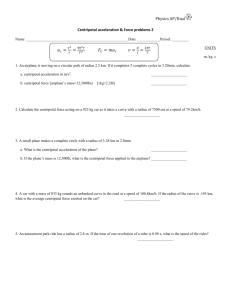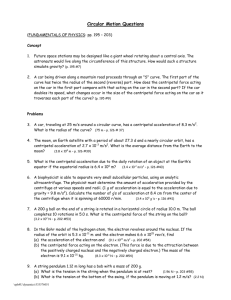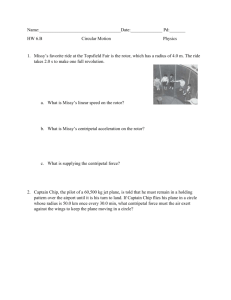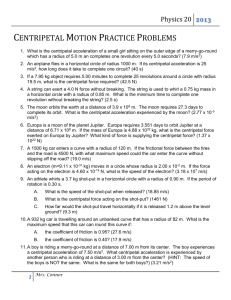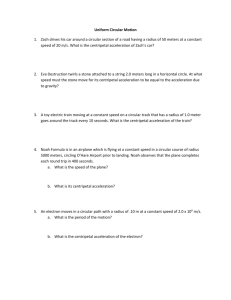Circular Motion & Gravitation Worksheet: Physics Problems
advertisement
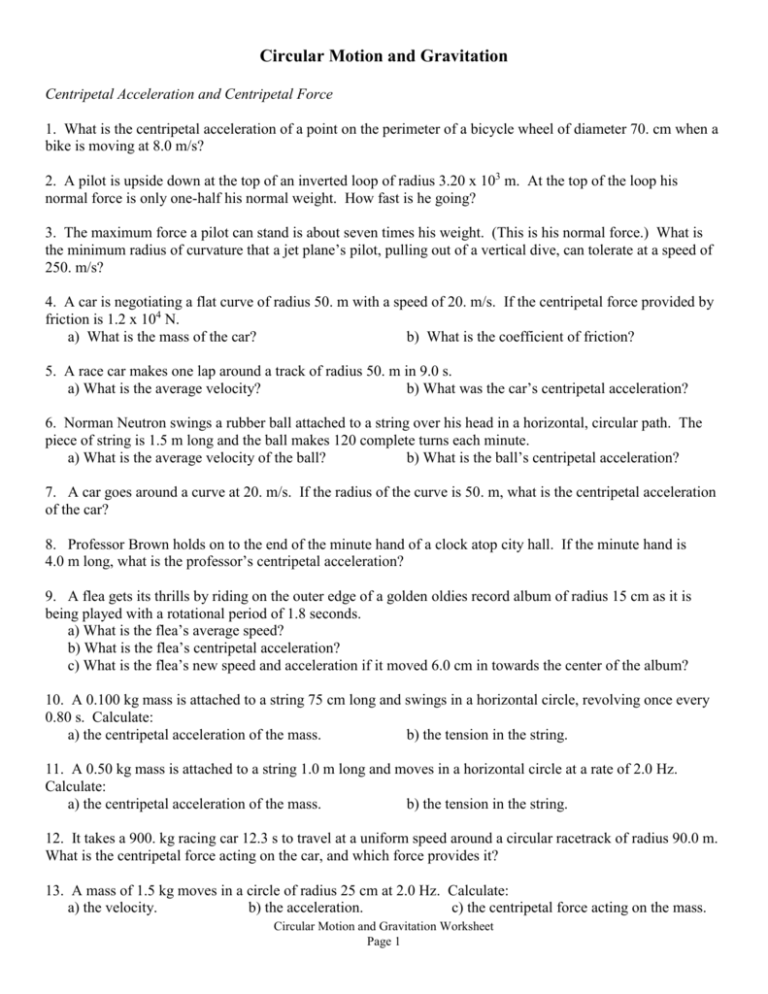
Circular Motion and Gravitation Centripetal Acceleration and Centripetal Force 1. What is the centripetal acceleration of a point on the perimeter of a bicycle wheel of diameter 70. cm when a bike is moving at 8.0 m/s? 2. A pilot is upside down at the top of an inverted loop of radius 3.20 x 103 m. At the top of the loop his normal force is only one-half his normal weight. How fast is he going? 3. The maximum force a pilot can stand is about seven times his weight. (This is his normal force.) What is the minimum radius of curvature that a jet plane’s pilot, pulling out of a vertical dive, can tolerate at a speed of 250. m/s? 4. A car is negotiating a flat curve of radius 50. m with a speed of 20. m/s. If the centripetal force provided by friction is 1.2 x 104 N. a) What is the mass of the car? b) What is the coefficient of friction? 5. A race car makes one lap around a track of radius 50. m in 9.0 s. a) What is the average velocity? b) What was the car’s centripetal acceleration? 6. Norman Neutron swings a rubber ball attached to a string over his head in a horizontal, circular path. The piece of string is 1.5 m long and the ball makes 120 complete turns each minute. a) What is the average velocity of the ball? b) What is the ball’s centripetal acceleration? 7. A car goes around a curve at 20. m/s. If the radius of the curve is 50. m, what is the centripetal acceleration of the car? 8. Professor Brown holds on to the end of the minute hand of a clock atop city hall. If the minute hand is 4.0 m long, what is the professor’s centripetal acceleration? 9. A flea gets its thrills by riding on the outer edge of a golden oldies record album of radius 15 cm as it is being played with a rotational period of 1.8 seconds. a) What is the flea’s average speed? b) What is the flea’s centripetal acceleration? c) What is the flea’s new speed and acceleration if it moved 6.0 cm in towards the center of the album? 10. A 0.100 kg mass is attached to a string 75 cm long and swings in a horizontal circle, revolving once every 0.80 s. Calculate: a) the centripetal acceleration of the mass. b) the tension in the string. 11. A 0.50 kg mass is attached to a string 1.0 m long and moves in a horizontal circle at a rate of 2.0 Hz. Calculate: a) the centripetal acceleration of the mass. b) the tension in the string. 12. It takes a 900. kg racing car 12.3 s to travel at a uniform speed around a circular racetrack of radius 90.0 m. What is the centripetal force acting on the car, and which force provides it? 13. A mass of 1.5 kg moves in a circle of radius 25 cm at 2.0 Hz. Calculate: a) the velocity. b) the acceleration. c) the centripetal force acting on the mass. Circular Motion and Gravitation Worksheet Page 1 14. A 2.0 kg object is tied to the end of a cord and whirled in a horizontal circle of radius 4.0 m at 3.0 Hz. Determine: a) the velocity of the object. b) the acceleration of the object. c) the pull of the object. 15. Compute the centripetal acceleration of an object on the equator. Use an equatorial radius of 6400 km. The Earth makes one revolution in a day. (1 km = 1000 m) 16. A steel beam is rotated in a horizontal plane to provide the centripetal acceleration for training pilots. If the pilot sits 2.0 m from the center of rotation, at what speed must he rotate to experience a horizontal centripetal acceleration of 78 m/s2? 17. A 0.30 kg mass is attached to a long string and revolves clockwise (looking down from the top) in a horizontal circle of radius 0.10 m with a speed of 0.50 m/s and a period of 1.3 s. a) Determine the centripetal acceleration of the mass. b) What force is acting through the string? 18. Calculate the centripetal acceleration of the Earth towards the Sun. (r = 1.5 x 1011 m) 19. A 900.-kg car moving at 10.0 m/s takes a turn around a circle with a radius of 25.0 m. Determine the acceleration and the net force acting upon the car. 20. A 95-kg halfback makes a turn on the football field. The halfback sweeps out a path which is a portion of a circle with a radius of 12-meters. The halfback makes a quarter of a turn around the circle in 2.1 seconds. Determine the speed, acceleration and net force acting upon the halfback. 21. A 1.50-kg bucket of water is tied by a rope and whirled in a circle with a radius of 1.00 m. At the top of the circular loop, the speed of the bucket is 4.00 m/s. Determine the acceleration, the centripetal force and the perceived weight (i.e., the tension). 22. A 1.50-kg bucket of water is tied by a rope and whirled in a circle with a radius of 1.00 m. At the bottom of the circular loop, the speed of the bucket is 6.00 m/s. Determine the acceleration, the centripetal force and the perceived weight. 23. A car racing on a flat track travels at 20.0 m/s around a curve with a 65.0-m radius. a) Find the car’s centripetal acceleration. b) What minimum coefficient of static friction between the tires and road is necessary for the car to round the curve without slipping? 24. A 60.-kg merry-go-round worker stands on the ride’s platform 4.0 m from the center. If her speed as she goes around the circle is 5.0 m/s, what is the force of friction needed to keep her from falling off the platform? Answers 1) 180 m/s2 2) 217 m/s 3) 1060 m 4a) 1500 kg 4b) 0.82 5a) 35 m/s 5b) 25 m/s2 6a) 19 m/s 6b) 240 m/s2 7) 8.0 m/s2 -5 2 2 2 8) 1.2 x 10 m/s 9a) 0.52 m/s 9b) 1.8 m/s 9c) 0.31 m/s, 1.1 m/s 10a) 46 m/s2 10b) 4.6 N 11a) 160 or 170 m/s2 11b) 80. or 85 N 12) 2.11 x 104 N, friction 2 13a) 3.1 m/s 13b) 38 m/s 13c) 57 N 14a) 76 m/s 14b) 1400 m/s2 14c) 2800 N 15) 0.034 m/s2 16) 12 m/s 17a) 2.5 m/s2 17b) 0.75 N 2 2 3 18) 0.0060 m/s 19) 4.00 m/s , 3.60 x 10 N 20) 9.0 m/s, 6.8 m/s2, 640 or 650 N 21) 16.0 m/s2, 24.0 N, 9.30 N 22) 36.0 m/s2, 54.0 N, 69.0 N 23a) 6.15 m/s2 23b) 0.628 24) 380 N Circular Motion and Gravitation Worksheet Page 2 Newton’s Law of Gravitation General Information: The mass of the Earth is 5.98 x 1024 kg, and the radius of the Earth is 6.38 x 106 m. 1. Calculate the force of gravity between you and the person sitting next to you in class, assuming you both have masses of 60.0 kg and are sitting 1.20 m apart. 2. Two tennis balls have a mass of 0.25 kg each and they are placed so that there is a distance of 42 cm between their centers. What is the gravitational force between the two tennis balls? 3. Two objects with the same mass are placed 60. cm apart. If the gravitational force between the objects is 7.0 x 10-9 N, what is the mass of each object? 4a. Use the universal gravitation formula to find the weight of a 10. kg object on the surface of the Earth. b. Find the object’s weight using Fg = mg. 5. The acceleration of gravity on the moon is one-sixth what it is on Earth. The radius of the moon is one-fourth that of the Earth. Determine the moon’s mass. 6. Two objects, with masses m1 and m2, are originally a distance r apart. The magnitude of the force between them is F. If the masses are changed to 2m1 and 2m2 and the distance is changed to 4r, what is the magnitude of the new gravitational force in terms of F? 7. What is the gravitational attraction between two protons (mproton = 1.67 x 10-27 kg) at a distance of 5.0 x 10-15 m, about the diameter of the nucleus of an atom? 8. State how the force changes as the following is altered: a) both masses are tripled b) distance of separation is reduced to ¾ the original distance c) separation is tripled d) both masses are doubled and separation is quadrupled 9. The center of the moon and the center of the Earth are 3.80 x 105 km apart. The mass of the moon is approximately 7.36 x 1022 kg, while the mass of the Earth is 5.98 x 1024 kg. a) Calculate the Earth’s pull on the moon. b) Calculate the moon’s pull on the Earth. 10. The space shuttle typically orbits 400. km above the Earth’s surface. How much would a 2000. kg part for the space shuttle weigh when it has been lifted to that orbit in the shuttle’s cargo bay? 11. What is the acceleration due to gravity to 5 significant figures at the top of Mt. Everest which is 8400 m above sea level? 12. Calculate the force of gravity between the Earth and Venus (mass = 4.9 x 1024 kg) when they are at their closest distance from each other, 3.8 x 1010 m. Answers 1) 1.67 x 10-7 N 5) 6.23 X 1022 kg 8c) F x (1/9) 11) 9.7733 m/s2 2) 2.4 x 10-11 N 6) ¼ F 8d) F x (¼) 12) 1.4 x 1018 N 3) 6.1 kg 7) 7.4 x 10-36 N 9a) 2.03 x 1020 N 4a) F = 98 N 8a) F x 9 9b) 2.03 x 1020 N Circular Motion and Gravitation Worksheet Page 3 4b) Fg = 98 N 8b) F x (16/9) 10) 17400 N


